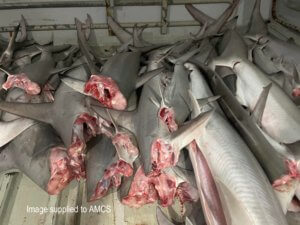Shocking pictures captured covertly on a fishing vessel in Northern Territory waters reveal how hammerhead sharks are being legally fished for fins and flesh despite being endangered in Australian waters.
The Australian Marine Conservation Society (AMCS) and Humane Society International (HSI), who were handed the images, say endangered hammerheads are likely ending up on our plates, labelled generically as ‘flake’ – a term that should only be used for gummy sharks which aren’t endangered.
 The images showing piles of dead great and scalloped hammerhead sharks stashed in a fishing boat operating in the Offshore Net and Line Fishery (ONLF) illustrate that Australia needs drastic improvement to protect endangered animals from being fished and becoming food for us and our trading partners, the marine conservationists say.
The images showing piles of dead great and scalloped hammerhead sharks stashed in a fishing boat operating in the Offshore Net and Line Fishery (ONLF) illustrate that Australia needs drastic improvement to protect endangered animals from being fished and becoming food for us and our trading partners, the marine conservationists say.
AMCS shark scientist Dr Leonardo Guida said: “Although it looks grim, it is perfectly legal to kill and process an endangered hammerhead shark in Australia.
“Hammerheads are killed in Australia for their highly-prized fins and meat. Although fins appear on export records, hammerhead meat is essentially absent suggesting it is consumed domestically (1). There is no legal requirement to call shark meat, commonly known as ‘flake’, for what species it is or where it’s from, so this is how we could be inadvertently eating an endangered species with our chips.
“We want to see fishing rules across Australia tightened so that they support the full protection and recovery of the endangered great and scalloped hammerhead sharks, which can both be seen in the pictures.
“Federal Environment Minister Sussan Ley has the opportunity in the next few weeks to better protect endangered hammerheads in Northern Territory’s shark fishery, the Offshore Net and Line Fishery. She can do this by granting this fishery the ability to trade overseas if it abides by stricter conditions like cameras on all boats and putting scientifically-determined trigger limits on hammerheads. This means that when a certain amount are killed the fishery has to close.
“Cameras on boats will help fisheries managers understand the full picture of what species, how many and where they’re being caught.”
Lawrence Chlebeck, marine biologist with HSI said removing a loophole in Australia’s environment law – the Environment Protection and Biodiversity Conservation Act 1999 (EPBC Act) – would also assist the recovery of scalloped hammerheads.
“Currently, the scalloped hammerhead is listed as ‘Conservation Dependent’ under the EPBC act, which allows endangered and critically endangered fish to be commercially fished and traded,” he said.
“Australian scientific assessment of the numbers of scalloped hammerhead show it meets the criteria for an Endangered status, which would provide the species with protection from fishing (2).”
Up to 200 tonnes of scalloped and 100t of great hammerhead, equivalent to at least 26,000 individual sharks (3), can be legally fished and retained in Australia per year. The NT is permitted to retain up to 50t of each of scalloped and great hammerheads per year.
Studies show only 2 in 10 hammerheads caught are alive when they are thrown back (discarded) (4). Even then, those that are thrown back alive have a slim chance of survival because of the stress endured during capture.
References
1. McCrea, J (2021) “Review of the Non-Detriment Finding for CITES Appendix II Listed Hammerhead Shark Species” Australia: Self published, 2021.
2. Kyne, P.M.et al. (2021) “The Action Plan for Australian Sharks and Rays 2021.” Report. Hobart: NESP Marine Biodiversity Hub.
3. Kilograms (whole weight of shark) converted to individual scalloped and great hammerheads using conversion factors of 2.3kg and 15.7kg, respectively. See trade volumes in McCrea J-A (2021) ‘Review of the Non-Detriment Finding for CITES Appendix II listed Hammerhead Shark Species.’ (Self published: Australia).
4. Dapp, DR., et al. (2016) “Respiratory Mode and Gear Type Are Important Determinants of Elasmobranch Immediate and Post‐release Mortality.” Fish and Fisheries 17, no. 2: 507–24.